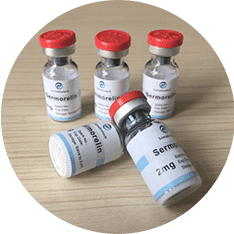
Unlock a More Youthful You With Hormone Replacemment Therapy In Crandon Lakes, NJ
Aging is inevitable, and for many, it signals the beginning of a new chapter - one where you cross off bucket list items and live life to the fullest, on your own terms. However, for some women, aging is a horrible prospect, filled with chronic fatigue, irritability, and inability to perform in the bedroom. If you're concerned about life in middle age and beyond, we've got great news: there are easy, proven steps that you can take to help stop the negative effect of aging.
Global Life Rejuvenation was founded to give women a new lease on life - one that includes less body fat, fewer mood swings, and more energy as you age. If you're ready to look and feel younger, it's time to consider HRT (hormone replacement therapy), and growth hormone peptides. These therapies for men and women are effective, safe, and customized to fit your goals, so you can keep loving life as you get older.
HRT, and growth hormone peptide therapies bridge the gap between your old life and the more vibrant, happier version of you. With a simple click or call, you can be well on your way to a brighter future. After all, you deserve to be the one in charge of your wellness and health. Now, you have the tools to do so - backed by science and applied by our team of HRT experts with more than 13 years of experience.
What is HRT?
As women age, their hormones begin to go through changes that affect their day-to-day lives. For women, hormone deficiency and imbalance usually occur during menopause and can cause chronic fatigue, hot flashes, and mood swings, among other issues. Hormone replacement therapy helps correct hormone imbalances in women, helping them feel more vibrant and virile as they age.
Often, HRT treatments give patients enhanced quality of life that they didn't think was possible - even in their 60's and beyond.
The benefits for women are numerous and are available today through Global Life Rejuvenation.
HORMONE REPLACEMENT THERAPY
HRT and Anti-Aging Medicine for Women in Crandon Lakes, NJ
As women age, their bodies begin to go through significant changes that affect their quality of life. This change is called menopause and marks the end of a woman's menstrual cycle and reproduction ability. Though there is no specific age when this change occurs, the average age of menopause onset is 51 years old. However, according to doctors, menopause officially starts 12 months after a woman's final period. During the transition to menopause, women's estrogen and other hormones begin to deplete.
As that happens, many women experience severe symptoms. These symptoms include:
- Hot Flashes
- Chronic Fatigue
- Incontinence
- Trouble Sleeping
- Dryness
- Muscle Loss
- Fat Gain
- Mood Swings
The symptoms of hormone deficiency can be concerning and scary for both women and their spouses. However, if you're getting older and notice some of these symptoms, there is reason to be hopeful. Hormone replacement therapy and anti-aging medicine for women can correct imbalances that happen during menopause. These safe, effective treatments leave you feeling younger, healthier, and more vibrant.


What Causes Menopause?
The most common reason for menopause is the natural decline in a female's reproductive hormones. However, menopause can also result from the following situations:
Oophorectomy: This surgery, which removes a woman's ovaries, causes immediate menopause. Symptoms and signs of menopause in this situation can be severe, as the hormonal changes happen abruptly.
Chemotherapy: Cancer treatments like chemotherapy can induce menopause quickly, causing symptoms to appear shortly after or even during treatment.
Ovarian Insufficiency: Also called premature ovarian failure, this condition is essentially premature menopause. It happens when a woman's ovaries quit functioning before the age of 40 and can stem from genetic factors and disease. Only 1% of women suffer from premature menopause, but HRT can help protect the heart, brain, and bones.
Common Issues for Women During Menopause
For many women, menopause is a trying time that can be filled with many hormonal hurdles to jump through. A little knowledge can go a long way, whether you're going through menopause now or are approaching "that" age.
Here are some of the most common issues that women experience during menopause:

Depression
If you're a woman going through menopause and find that you have become increasingly depressed, you're not alone. It's estimated that 15% of women experience depression to some degree while going through menopause. What many women don't know is that depression can start during perimenopause, or the years leading up to menopause.
Depression can be hard to diagnose, especially during perimenopause and menopause. However, if you notice the following signs, it might be time to speak with a physician:
- Mood Swings
- Inappropriate Guilt
- Chronic Fatigue
- Too Much or Too Little Sleep
- Lack of Interest in Life
- Overwhelming Feelings
Remember, if you're experiencing depression, you're not weak or broken - you're going through a very regular emotional experience. The good news is that with proper treatment from your doctor, depression isn't a death sentence. And with HRT and anti-aging treatment for women, depression could be the catalyst you need to enjoy a new lease on life.

Hot Flashes
Hot flashes - they're one of the most well-known symptoms of menopause. Hot flashes are intense, sudden feelings of heat across a woman's upper body. Some last second, while others last minutes, making them incredibly inconvenient and uncomfortable for most women.
Symptoms of hot flashes include:
- Sudden, Overwhelming Feeling of Heat
- Anxiety
- High Heart Rate
- Headache
- Nausea
- Dizziness
Typically, hot flashes are caused by a lack of estrogen. Low estrogen levels negatively affect a woman's hypothalamus, the part of the brain that controls body temperature and appetite. Low estrogen levels cause the hypothalamus to incorrectly assume the body is too hot, dilating blood vessels to increase blood flow. Luckily, most women don't have to settle for the uncomfortable feelings that hot flashes cause. HRT treatments for women often stabilize hormones, lessening the effects of hot flashes and menopause in general.

Mood Swings
Mood swings are common occurrences for most people - quick shifts from happy to angry and back again, triggered by a specific event. And while many people experience mood swings, they are particularly common for women going through menopause. That's because, during menopause, the female's hormones are often imbalanced. Hormone imbalances and mood swings go hand-in-hand, resulting in frequent mood changes and even symptoms like insomnia.
The rate of production of estrogen, a hormone that fluctuates during menopause, largely determines the rate of production the hormone serotonin, which regulates mood, causing mood swings.
Luckily, HRT and anti-aging treatments in Crandon Lakes, NJ for women work wonders for mood swings by regulating hormone levels like estrogen. With normal hormone levels, women around the world are now learning that they don't have to settle for mood swings during menopause.

Weight Gain
Staying fit and healthy is hard for anyone living in modern America. However, for women with hormone imbalances during perimenopause or menopause, weight gain is even more serious. Luckily, HRT treatments for women coupled with a physician-led diet can help keep weight in check. But which hormones need to be regulated?
- Estrogen: During menopause, estrogen levels are depleted. As such, the body must search for other sources of estrogen. Because estrogen is stored in fat, your body believes it should increase fat production during menopause. Estrogen also plays a big part in insulin resistance, which can make it even harder to lose weight and keep it off.
- Progesterone: Progesterone levels are also depleted during menopause. Progesterone depletion causes bloating and water retention, while loss of testosterone limits the body's ability to burn calories.
- Ongoing Stress: Stress makes our bodies think that food is hard to come by, putting our bodies in "survival mode". When this happens, cortisol production is altered. When cortisol timing changes, the energy in the bloodstream is diverted toward making fat. With chronic stress, this process repeatedly happens, causing extensive weight gain during menopause.

Low Libido
Lowered sexual desire - three words most men and women hate to hear. Unfortunately, for many women in perimenopausal and menopausal states, it's just a reality of life. Thankfully, today, HRT and anti-aging treatments Crandon Lakes, NJ can help women maintain a normal, healthy sex drive. But what causes low libido in women, especially as they get older?
The hormones responsible for low libido in women are progesterone, estrogen, and testosterone.
Progesterone production decreases during perimenopause, causing low sex drive in women. Lower progesterone production can also cause chronic fatigue, weight gain, and other symptoms. On the other hand, lower estrogen levels during menopause lead to vaginal dryness and even vaginal atrophy or loss of muscle tension.
Lastly, testosterone plays a role in lowered libido. And while testosterone is often grouped as a male hormone, it contributes to important health and regulatory functionality in women. A woman's testosterone serves to heighten sexual responses and enhances orgasms. When the ovaries are unable to produce sufficient levels of testosterone, it often results in a lowered sex drive.

Vaginal Dryness
Often uncomfortable and even painful, vaginal dryness is a serious problem for sexually active women. However, like hair loss in males, vaginal dryness is very common - almost 50% of women suffer from it during menopause.
Getting older is just a part of life, but that doesn't mean you have to settle for the side effects. HRT and anti-aging treatments for women correct vaginal dryness by re-balancing estrogen, progesterone, and testosterone. When supplemented with diet and healthy living, your vagina's secretions are normalized, causing discomfort to recede.

Fibroids
Uterine fibroids - they're perhaps the least-known symptom of menopause and hormone imbalances in women. That's because these growths on the uterus are often symptom-free. Unfortunately, these growths can be cancerous, presenting a danger for women as they age.
Many women will have fibroids at some point. Because they're symptomless, they're usually found during routine doctor exams. Some women only get one or two, while others may have large clusters of fibroids. Because fibroids are usually caused by hormone imbalances, hysterectomies have been used as a solution, forcing women into early menopause.
Advances in HRT and anti-aging medicine for women give females a safer, non-surgical option without having to experience menopause early. At Global Life Rejuvenation, our expert physicians will implement a customized HRT program to stabilize your hormones and reduce the risk of cancerous fibroid growth.

Endometriosis
Endometriosis symptoms are much like the effects of PMS, and include pelvic pain, fatigue, cramping, and bloating. While doctors aren't entirely sure what causes this painful, uncomfortable condition, most agree that hormones - particularly xenoestrogens - play a factor.
Endometriosis symptoms are much like the effects of PMS and include pelvic pain, fatigue, cramping, and bloating. While doctors aren't entirely sure what causes this painful, uncomfortable condition, most agree that hormones - particularly xenoestrogens - play a factor.
Xenoestrogen is a hormone that is very similar to estrogen. Too much xenoestrogen is thought to stimulate endometrial tissue growth. HRT for women helps balance these hormones and, when used with a custom nutrition program, can provide relief for women across the U.S.
Is HRT for Women the Right Answer?
Hormone stability is imperative for a healthy sex drive and for a normal, stress-free life during menopause. HRT and anti-aging treatments for women balance the hormones that your body has altered due to perimenopause or menopause.
HRT for women is a revolutionary step in helping women live their best lives, even as they grow older. However, at Global Life Rejuvenation, we know that no two patients are the same. That's why we specialize in holistic treatments that utilize HRT, combined with healthy nutrition, supplements, and fitness plans that maximize hormone replacement treatments.
If you've been suffering through menopause, is HRT the answer? That's hard to say without an examination by a trusted physician, but one thing's for sure. When a woman balances her hormone levels, she has a much better shot at living a regular life with limited depression, weight gain, mood swings, and hot flashes.
Here are just a few additional benefits of HRT and anti-aging treatments for females:


Benefits of HRT and Anti-Aging Medicine for Women in Crandon Lakes, NJ
Hormone imbalance causes a litany of issues. But with anti-aging treatments for women, females can better process calcium, keep their cholesterol levels safe, and maintain a healthy vagina. By replenishing the body's estrogen supply, HRT can relieve symptoms from menopause and protect against osteoporosis. But that's just the start.
Global Life Rejuvenation's patients report many more benefits of HRT and anti-aging medicine for women:
- Fewer Mood Swings
- Thicker Hair
- Stronger Bones
- Less Body Fat
- More Energy
- More Stamina
- Increased Sex Drive and Pleasure Sensations
- Better Cognitive Functions
- Improved Pain Receptors
- Less Hot Flashes and Night Sweats
- Lower Triglycerides
- Fewer Bladder Infections
If you're ready to feel better, look better, and recapture the vitality of your youth, it's time to contact Global Life Rejuvenation. It all starts with an in-depth consultation, where we will determine if HRT and anti-aging treatments for women are right for you. After all, every patient's body and hormone levels are different. Since all our treatment options are personalized, we do not have a single threshold for treatment. Instead, we look at our patient's hormone levels and analyze them on a case-by-case basis.

HRT from Global Life Rejuvenation
At Global Life Rejuvenation, we help women rediscover their youth with HRT treatment for women. We like to think of ourselves as an anti-aging concierge service, guiding and connecting our patients to the most qualified HRT physicians available. With customized HRT treatment plan for women, our patients experience fewer menopausal symptoms, less perimenopause & menopause depression, and often enjoy a more youth-like appearance.
Reverse Aging with Growth Hormone Peptides
Growth hormone peptides are an innovative therapy that boosts the natural human growth hormone production in a person's body. These exciting treatment options help slow down the aging process and give you a chance at restoring your youth.

What is Sermorelin?
Sermorelin is a synthetic hormone peptide, like GHRH, which triggers the release of growth hormones. When used under the care of a qualified physician, Sermorelin can help you lose weight, increase your energy levels, and help you feel much younger.

Benefits of Sermorelin
Human growth hormone (HGH) therapy has been used for years to treat hormone deficiencies. Unlike HGH, which directly replaces declining human growth hormone levels, Sermorelin addresses the underlying cause of decreased HGH, stimulating the pituitary gland naturally. This approach keeps the mechanisms of growth hormone production active.
- Benefits of Sermorelin include:
- Better Immune Function
- Improved Physical Performance
- More Growth Hormone Production
- Less Body Fat
- Build More Lean Muscle
- Better Sleep

What is Ipamorelin?
Ipamorelin helps to release growth hormones in a person's body by mimicking a peptide called ghrelin. Ghrelin is one of three hormones which work together to regulate the growth hormone levels released by the pituitary gland. Because Ipamorelin stimulates the body to produce growth hormone, your body won't stop its natural growth hormone production, which occurs with synthetic HGH.
Ipamorelin causes growth hormone secretion that resembles natural release patterns rather than being constantly elevated from HGH. Because ipamorelin stimulates the natural production of growth hormone, our patients can use this treatment long-term with fewer health risks.

Benefits of Ipamorelin
One of the biggest benefits of Ipamorelin is that it provides significant short and long-term benefits in age management therapies. Ipamorelin can boost a patient's overall health, wellbeing, and outlook on life.
When there is an increased concentration of growth hormone by the pituitary gland, there are positive benefits to the body. Some benefits include:
- Powerful Anti-Aging Properties
- More Muscle Mass
- Less Unsightly Body Fat
- Deep, Restful Sleep
- Increased Athletic Performance
- More Energy
- Less Recovery Time for Training Sessions and Injuries
- Enhanced Overall Wellness and Health
- No Significant Increase in Cortisol
Your New, Youthful Lease on Life with HRT for Women
Whether you are considering our HRT and anti-aging treatments for women in Crandon Lakes, NJ, we are here to help. The first step to reclaiming your life begins by contacting Global Life Rejuvenation. Our friendly, knowledgeable HRT experts can help answer your questions and walk you through our procedures. From there, we'll figure out which treatments are right for you. Before you know it, you'll be well on your way to looking and feeling better than you have in years!
 866-793-9933
866-793-9933
Request a Consultation
Latest News in Crandon Lakes, NJ
Tornado warning issued in Warren County; bad storms continue moving through N.J.
njhttps://www.nj.com/news/2012/09/tornado_warning_issued_in_warr.html
Brad Anthony Detetta/Severe NJ WeatherThe National Weather Service has issued another tornado warning tonight for Warren County, along with Sussex County and Monroe County in northeast Pennsylvania, as a severe thunderstorm was being tracked on radar.The latest tornado warning remains in effect until 10:45 p.m.As of 10:15 p.m., the storm was located near Werry Lake, 16 miles west of Newton, and was traveling east at 10 mph, the weather service said in a bulletin. The storm is expected to move near Flatbrookville in Walpa...
Brad Anthony Detetta/Severe NJ Weather
The National Weather Service has issued another tornado warning tonight for Warren County, along with Sussex County and Monroe County in northeast Pennsylvania, as a severe thunderstorm was being tracked on radar.
The latest tornado warning remains in effect until 10:45 p.m.
As of 10:15 p.m., the storm was located near Werry Lake, 16 miles west of Newton, and was traveling east at 10 mph, the weather service said in a bulletin. The storm is expected to move near Flatbrookville in Walpack Township by 10:35 p.m. and Five Points in Stillwater Township and Crandon Lakes by 10:45 p.m.
Earlier tonight, another tornado warning was issued for Warren County, but no funnel cloud or major damage was confirmed. Hour earlier, similar warnings were issued for Burlington and Camden counties as those areas got hit with dark clouds and heavy rain.
Weather service officials said they are sending a team to Camden County Wednesday to try to determine whether a tornado touched down in Mount Ephraim. The decision was based on residents' reports of trees down, roof damage and wires pulled from houses.
There were multiple reports of funnel clouds touching down near Moorestown and Maple Shade early this evening, according to a report by philly.com.
Severe thunderstorms continue to move through northwestern and southern New Jersey tonight, and they could produce torrential rain, large hail and powerful winds, according to the weather service. Additional rain is expected Wednesday as tropical moisture continues swirling through the Garden State.
Flood warnings remain in effect for several New Jersey counties at this hour, as storms produce torrential rain. And a series of severe thunderstorm warnings have been issued throughout the afternoon and evening.
The bad weather has triggered departure delays of up to 1 hour, 45 minutes at Newark Liberty International Airport tonight.
The storms affecting New Jersey today are remnants of Tropical Storm Isaac, which battered Louisiana and other southern states with torrential rain last week before tracking north and east.
Star-Ledger staff writers Len Melisurgo and Stephen Stirling contributed to this report.
Related coverage:
• Tornado warning issued for Burlington and Camden counties in N.J.
• Flash flood warnings issued for 6 N.J. counties, as heavy rain pounds region
Uncovering N.J.: Next to Gingerbread Castle, former paper mill is a fairy tale gone up in flames
Jersey's Besthttps://www.jerseysbest.com/community/uncovering-n-j-next-to-gingerbread-castle-former-paper-mill-is-a-fairy-tale-gone-up-in-flames/
Some ruins give a glimpse of a past that simply look like a failed industry laying to waste, but that’s not always the case. In the northern corner of New Jersey, one set of ruins helped a town become more established by becoming more attractive for families to move to, increasing its population. Essentially, they put this town on the map.Tucked in the woods behind the Gingerbread Castle (formally abandoned and soon-to-be restored) in Hamburg are the ruins of Hamburg Paper Mill. It was also known as Union Waxed and Parchment Pap...
Some ruins give a glimpse of a past that simply look like a failed industry laying to waste, but that’s not always the case. In the northern corner of New Jersey, one set of ruins helped a town become more established by becoming more attractive for families to move to, increasing its population. Essentially, they put this town on the map.
Tucked in the woods behind the Gingerbread Castle (formally abandoned and soon-to-be restored) in Hamburg are the ruins of Hamburg Paper Mill. It was also known as Union Waxed and Parchment Paper Co., and you can make out some of the wording on the smokestack that remains today.
Before the paper mill was erected in 1874, this site was where Edsall Furnace had existed. While there are no remnants of the iron furnace, it did have a dam and, when the paper mill was built, the furnace dam was raised an additional eight feet to help create more power for the paper mill. The paper mill was powered by a water wheel, which fed two larger turbines. A portion of that wheel can still be found on the site.
The paper mill provided steady work and employed many people in the community. During those times, even if a small industry provided work, it would attract families to move close to the area. Hamburg was looking promising because of the paper mill, and, as a result, the population grew. The company employed close to 300 people who would normally work more than 11 hours during the day; night shift workers would work around 13 hours. The work wasn’t complicated, so they didn’t mind working long hours.
The paper mill was also powered by eight boilers and a few furnaces. Manufacturing involved processing pulp with dye and chemicals. The fumes the mill produced were strong and carried through the town. The residents hardly complained and tolerated the smell because it was employing family, friends and neighbors.
The pulp was processed into tissue paper. The tissue paper was said to be high quality, and it was used to wrap fruit for transport to prevent spoilage. Fruit growers often sought out its tissue paper.
A view of the Hamburg Paper Mill in its heyday. Photo courtesy of Dave Rutan
There were railroad tracks near the mill, which provided vital transportation for the goods that were manufactured. It was also used to transport the pulp that was imported from Canada.
Hamburg Paper Mill started to become plagued with issues. Small fires started to break out, and floods started to occur more frequently. According to an article in The Morning Post dated March 4, 1902, “The dam at Hamburg Paper Mill broke early yesterday morning, demolishing part of the mill.” The ultimate demise happened in the 1930s when a massive fire destroyed everything that wasn’t concrete.
Much of the concrete ruins remain today, but nature is reclaiming them. Only one of the several smokestacks still stands, peering over the forest canopy. The ruins are still plagued by floods to this day.
Address: Gingerbread Castle Road, Hamburg, N.J. 07419 (view from the road; do not trespass)
Kathleen Butler writes about little-known local history so that others can venture out and explore these gems. She also has a YouTube channel, Rustic Ventures, as well as two published books: Abandoned Ruins on Public Lands in New Jersey and Abandoned Ruins of Eastern Pennsylvania.
Sign up for our Newsletter
Delivered to your inbox every other week on Thursdays, Jersey’s Best is pleased to offer a FREE subscription to Garden Statement, highlighting the most popular Jersey’s Best content.
N.J. weather: Thunderstorm threat returns this weekend after summer-like heat departs
lmelisurhttps://www.nj.com/weather/2023/04/nj-weather-thunderstorm-threat-returns-this-weekend-after-summer-like-heat-departs.html
UPDATE: Severe thunderstorm warnings issued in parts of N.J. region as strong storms with 60 mph winds sweep inNew Jersey’s brief taste of summer-like heat has come to an end ...
New Jersey’s brief taste of summer-like heat has come to an end Saturday morning and had been replaced by heavy cloud cover and a threat of rain showers — along with possible thunderstorms.
Forecasters from the National Weather Service say scattered rain showers will dampen the day, and some thunderstorms could pop up in the afternoon or evening. Although most of the storms are not expected to be severe enough to trigger warnings, some may be packed with gusty winds and small hail.
In addition, the weather service’s regional office in Mount Holly says some of the showers and thunderstorms could end up to be slow movers, so heavy downpours are not out of the question.
“There is potential for some locally heavy rainfall, perhaps an inch or two in a few spots, which could cause some localized minor flooding if it happens in the wrong place,” the weather service said in its morning forecast discussion.
If enough instability occurs in the atmosphere, small hail could be produced by some of the storms, the weather service noted. “Best chance for all of these issues (heavy downpours and small hail) is from I-95 north and west, especially across the Lehigh Valley.”
UPDATE (1:15 p.m.): A few thunderstorms have developed in the Lehigh Valley area of eastern Pennsylvania, including some strong ones, prompting a severe thunderstorm warning for parts of Carbon, Lehigh, Monroe, and Northampton counties, effective until 1:30 p.m. Saturday.
At 1:10 p.m. the weather service issued a special weather statement saying a strong thunderstorm was moving across northwestern Sussex County and could generate wind gusts up to 40 mph and penny-size hail, with those impacts possible through 1:45 p.m.
In addition, a flash flood warning was issued for parts of the Lehigh Valley at 1:25 p.m., effective until 4:30 p.m. Saturday, because radar has indicated as much as 2 to 2.5 inches of rain has already fallen, with more on the way.
If you were hoping for another rare April beach day, like the ones we just experienced on Thursday and Friday, you will be disappointed. In addition to the cloudy skies and potential for rain, temperatures across New Jersey will be mainly in the 70s on Saturday, and closer to the 60s along the Jersey Shore.
That’s not bad for the middle of April, but it’s a far cry from the upper 80s and low 90s that broke several daily records during the past two days.
The mercury soared to 93 degrees at Newark Liberty International Airport on Friday, crushing the airport’s previous record high of 88 degrees for April 14. New York City’s Central Park recorded a high of 91 degrees Friday afternoon, also setting a new record for that date.
On Thursday, daily record highs were set in Newark (92 degrees) and Atlantic City International Airport in Pomona (87 degrees), and tied at Trenton Mercer Airport in Ewing (85 degrees).
Although record highs weren’t set at the AC Airport or the Atlantic City Marina, both locations broke records for their warmest low temperatures on April 14, the weather service said. The lowest temperature reading throughout the day was 63 degrees at the airport and 60 degrees at the marina.
Sunday is expected to start out with patchy fog, with mostly cloudy skies in the afternoon and temperatures in the mid-60s to low 70s. Forecasters say another threat of rain showers and thunderstorms will return late Sunday night into early Monday morning.
Thank you for relying on us to provide the local weather news you can trust. Please consider supporting NJ.com with a subscription.
Swartswood Lake under 'watch’ after harmful algae is confirmed
Lori Comstockhttps://www.njherald.com/story/news/2020/07/24/swartswood-lake-under-watchrsquo-after-harmful-algae-is-confirmed/113408914/
[email protected] — A year after Swartswood Lake was inundated with a harmful algal bloom that temporarily shut down the popular locale before the start of summer, the lake is again experiencing dangerous bacteria.While several state parks have reopened for swimming following the coronavirus outbreak, including Hopatcong State Park, swimming from the state’s third largest freshwater lake has remained closed indefinitely. The park has reopened for fishing, canoeing/kayaking, camping and hik...
HAMPTON — A year after Swartswood Lake was inundated with a harmful algal bloom that temporarily shut down the popular locale before the start of summer, the lake is again experiencing dangerous bacteria.
While several state parks have reopened for swimming following the coronavirus outbreak, including Hopatcong State Park, swimming from the state’s third largest freshwater lake has remained closed indefinitely. The park has reopened for fishing, canoeing/kayaking, camping and hiking.
Residents are warned to not drink the water or eat fish caught in the lake. Canoeists or kayakers are urged to take caution and pets and livestock should be kept away from the water, according to information from the state’s Department of Environmental Protection, or DEP.
Data collected and later posted on July 23 from the main beach area and from a boat launch area of Camp Lou Henry Hoover, a Girl Scout residential camp site, showed heightened levels of a cyanobacteria that causes blue-green algal blooms. The Girl Scout summer camp is not operating due to the coronavirus, according to the Girl Scouts’ website.
To be considered safe, a water sample must contain less than 20,000 cyanobacteria cells per milliliter, the state’s DEP indicates. Toxins from the main beach contained 25,800 per milliliter and those from Camp Hoover contained 34,250 per milliliter — numbers that fall within the DEP’s guidelines to issue a “watch” notice for the lake.
While cell counts of 80,000 per milliliter or more are required to shut down a beach area for swimming, a “watch” still leaves the potential for residents to suffer allergenic or health effects from the water.
A skin rash, the mildest symptom, can occur from direct skin contact with the bacteria, but cyanobacteria produces “extremely dangerous toxins,” and ingestion, according to the environmental agency, can “sicken or kill” animals or people. If exposed to the toxin, skin should be immediately rinsed off with clean water as soon as possible.
If ingested, the toxins can cause the following symptoms in humans: abdominal pain, headache, sore throat, vomiting, nausea, dry cough, diarrhea, blistering around the mouth and pneumonia. If any symptoms appears after exposure to the lake, seek medical attention.
Pets, livestock or wildlife, if exposed, can experience lethargy, stumbling, loss of appetite or falling.
In the DEP’s color-coded warning system, a new feature this year, an interactive map shows harmful algal blooms have caused the closure of portions of seven lakes or ponds statewide so far this summer — but none are public beach areas.
While a “watch” is in place for several spots along the West Milford portion of Greenwood Lake, Browns Point, a small park area, was placed under an “advisory” on July 6. The advisory indicates that cyanobacteria cells per milliliter are above 100,000, with a moderate risk of health effects just from touching the water.
The harmful bacteria shut down Greenwood Lake for most of the season last year and marred the July 4 holiday for boaters and swimmers of the state’s largest freshwater lake in Hopatcong in 2019. The lake closed for nearly two months.
Several spots have been tested for the blooms along Lake Hopatcong, the latest on July 16, but there have been no confirmed HABs, the DEP’s map shows. Spots along Crandon Lakes, which straddles Hampton and Stillwater, also tested negative.
The state experienced 39 algal blooms in 2019, according to the DEP.
The algae usually blooms during the summer season when water temperatures are warmer than usual, according to the U.S. Environmental Protection Agency. Algal blooms absorb sunlight, which makes water even warmer and promotes more blooms, the agency states.
The Swartswood Lake swimming area is typically open annually between Memorial Day and Labor Day but was closed indefinitely due to the coronavirus. Residents can still hike, bike, picnic and camp, among other activities, within Swartswood State Park.
It was not immediately known if Swartswood Lake would reopen this summer. Additional information from the DEP was not immediately returned.
For those seeking to cool off from the warm weather, there are several state parks that have since reopened for swimming including High Point, Wawayanda and Hopatcong.
For more information about swim sites that are open and closed, visit: https://www.state.nj.us/dep/parksandforests/parks/swimming_schedule.html.
Lori Comstock can also be reached on Twitter: @LoriComstockNJH, on Facebook:www.Facebook.com/LoriComstockNJH or by phone: 973-383-1194.
Snow squall warnings issued in 13 N.J. counties
lmelisurhttps://www.nj.com/weather/2019/12/snow-squall-warning-issued-in-2-nj-counties.html
The National Weather Service issued rare snow squall warnings for 13 counties in northern and central New Jersey Wednesday afternoon, because heavy snow showers have been popping up in the region as an arctic front moves through, making driving conditions dangerous.The first warning was issued at 1:30 p.m. for all of Sussex County and the north-central area of Warren County, and remained in effect until 2:30 p.m. Wednesday. It also included Monroe County and ce...
The National Weather Service issued rare snow squall warnings for 13 counties in northern and central New Jersey Wednesday afternoon, because heavy snow showers have been popping up in the region as an arctic front moves through, making driving conditions dangerous.
The first warning was issued at 1:30 p.m. for all of Sussex County and the north-central area of Warren County, and remained in effect until 2:30 p.m. Wednesday. It also included Monroe County and central Carbon County in northeastern Pennsylvania.
Drivers should be aware of white-out conditions occurring quickly, the weather service said, advising motorists to slow down and turn on their headlights.
UPDATE (2:35 p.m.): Another snow squall warning was issued at 2:23 p.m., covering all of Sussex County, all of Warren County and the northwestern region of Morris County. This is effective until 3:30 p.m. and also includes Carbon County, Monroe County, north-central Lehigh County and northern Northampton County in Pennsylvania.
UPDATE (3:05 p.m.): A third snow squall warning was issued at 3 p.m. for Morris County, northeastern Somerset County, north-central Monmouth County and northeastern Middlesex County, effective until 3:45 p.m. This warning area includes the Garden State Parkway between mile markers 116 and 134, Interstate 287 between mile markers 0 and 14, and between mile markers 22 and 54, Interstate 78 between mile markers 32 and 42, Interstate 80 between mile markers 28 and 48, and the New Jersey Turnpike between exits 10 in Edison and 13 in Elizabeth.
UPDATE (3:30 p.m.): Another snow squall warning was issued at 3:18 p.m. for Bergen, Essex, Hudson, Union and eastern Passaic counties, effective until 4:15 p.m. Wednesday.
UPDATE (4:05 p.m.): A new snow squall warning was issued at 4 p.m. for Essex, Hudson and Union counties, along with New York City, effective until 5:30 p.m. Wednesday. The weather service’s New York regional office is warning drivers they could face “brief zero visibility in heavy snow and blowing snow,” along with wind gusts up to 40 mph. Snow could quickly accumulate about a half-inch to 1 inch in these areas.
UPDATE (4:15 p.m.): A new snow squall warning was issued at 4:10 p.m. for Hunterdon, Mercer, Middlesex, Morris, Somerset and Warren counties in New Jersey, along with Bucks County in Pennsylvania, effective until 4:45 p.m.
UPDATE (4:45 p.m.): The National Weather Service said an area of heavy snow will be moving through parts of Burlington, Hunterdon, Mercer, Middlesex, Monmouth, Morris, Ocean, Somerset and Warren counties now through 5:45 p.m. Driving conditions can rapidly deteriorate.
Snow squalls are intense bursts of heavy snow that move quickly and often drop a fast coating of snow on the ground, creating slick driving conditions. They also tend to bring strong winds, which blow the snow sideways, sharply reducing visibility for drivers.
Many snow squalls are short-lived, sometimes dissipating after 10 or 15 minutes, but some can last as long as an hour or even longer.
In addition to the threat of snow squalls on Wednesday, some light scattered snow showers are possible in northern and central New Jersey during the afternoon and evening, the National Weather Service said. No accumulation is expected from the snow showers, but the snow squalls could drop a quick inch of snow.
New Jersey will experience a big cool-down Wednesday night after the arctic front sweeps through, with temperatures dropping into the teens and low 20s by Thursday morning. The mercury might not climb above the freezing mark of 32 degrees all day on Thursday, setting the stage for another frigid morning on Friday.
The second squall warning says “a dangerous snow squall was located along a line extending from High Point to near Crandon Lakes to near Long Pond to near Blakeslee to near Drums, moving south at 25 mph.”
Drivers in those areas can expect to face poor visibility in heavy snow and blowing snow, and wind gusts up to 30 mph, the weather service said in its warning, noting there’s a risk of “dangerous life-threatening travel.”
The warning area includes the following highways: Interstate 80 in New Jersey between mile markers 0 and 28; Interstate 80 in Pennsylvania between mile markers 278 and 314; Northeast Extension between exits A74 and A95; Interstate 380 in Pennsylvania between mile markers 0 and 13.
The squalls that moved through northern New Jersey Wednesday afternoon dropped a quick 1.3 inches of snow in the Randolph area of Morris County, according to the National Weather Service.
The Highland Lakes area of Sussex County was coasted with 0.6 inches of snow and the Mount Pocono area of northeastern Pennsylvania received a fast 1.2 inches of snow.
Safety tips for drivers
Live weather radar
Disclaimer:


